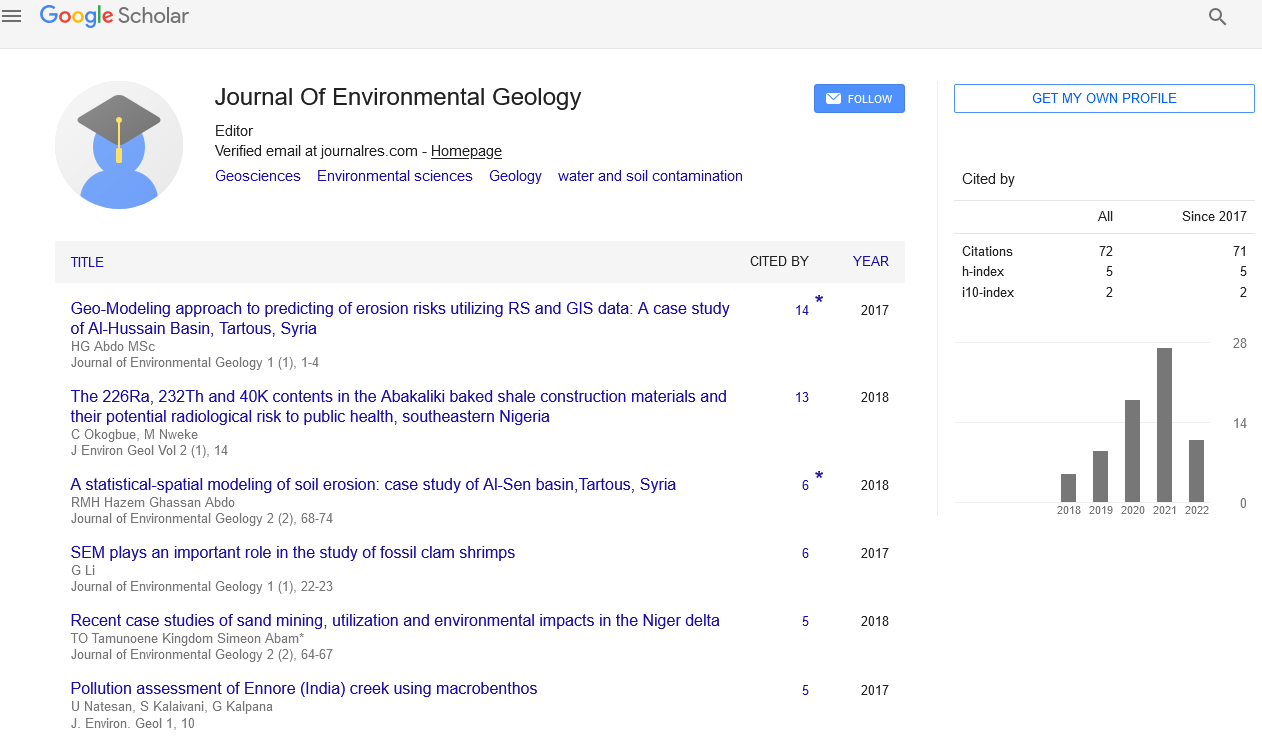Geological disaster
Received: 21-Feb-2021 Accepted Date: Mar 17, 2021; Published: 25-Mar-2021
Citation: Jones S. Geological disaster. J Environ Geol. 2021;5(2):1.
This open-access article is distributed under the terms of the Creative Commons Attribution Non-Commercial License (CC BY-NC) (http://creativecommons.org/licenses/by-nc/4.0/), which permits reuse, distribution and reproduction of the article, provided that the original work is properly cited and the reuse is restricted to noncommercial purposes. For commercial reuse, contact reprints@pulsus.com
Editorials
Geological disasters have the characteristics of occurring quickly, having a large impact, and becoming devastating. Unexpected geological hazards, such as mountainous geography, arising in every area, and the severe damage and damage suffered by local people and transportation services. The task of geological hazard forecasting is critical in order to prevent or minimize the loss of life as much as possible. Natural disasters are categorised as geological hazards depending on their sources. In addition to the risks to personal and property protection posed by natural threats, people would suffer larger losses as a result of a sequence of secondary disasters. The ecosystem is ultimately affected as a result of resource extraction. Pollution and destruction of the atmosphere and water are very easy to detect because they circulate easily due to the origin of fluids, and because air and water are important for human life, people pay greater attention to the environment of air and water. Because of its gradual transition, the lithosphere’s environmental crisis has a limited chance of creating issues that are dangerous to humans; hence, the relevance of geological environmental problems is low. China’s production and exploitation of natural resources has accelerated since the late 1980s. However, owing to a lack of environmental knowledge and a need for benefit at the moment, mining exploration resulted in substantial harm to the geological ecosystem of mines. Geological risks must be avoided and regulated at all costs. The mitigation and management of geological hazards refers to using appropriate geological engineering techniques to adjust the occurrence mechanism of geological hazards such as landslides, rubble flows, earth subsidence, ground fissures, and land subsidence that are dangerous to people’s lives and property and are caused by natural or human causes. The topography of geologically hazarded mining areas will change drastically. If the appropriate treatment is not implemented, the local vegetation will be severely harmed, a substantial amount of mineral extraction fields will be depleted, and the local ecological equilibrium will be disrupted, all of which are not conducive to long-term sustainability.
Prevention and Control
Engineering measures: Each natural hazard is split into two parts: the disaster-causing body and the disaster-affected body, and then engineering treatment can be applied in two ways. Surface excavation, demolition of slides that have been removed from bedrock, and stabilisation of loosened slopes by supports are used to reduce the gravitational potential energy of the slides that can cause immediate damage for disaster-causing areas of landslides; for landslides, disaster-causing parts are treated similarly to landslides. Disastercausing sections are treated similarly to landslides, and engineering teams are routinely organised to clean or fix loosened or delaminated rock and dirt. Blocking and intercepting can be used by disaster-affected bodies to minimise disruption, such as setting up blocking nets on both sides of highways that pass through hillsides. Preventive steps for debris flows are similar to those for landslides and collapses, such as load mitigation and drainage. Interception and dredging of fluids, as well as transfer and dredging of silt, are all steps taken during disasters. To avoid secondary cracking, prompt draining and filling of cracks and collapses should be carried out after the occurrence of field cracks and collapses.
Administrative measures: One of the sources of geological hazards is man-made infrastructure practices. In the face of geological disasters, the government must popularize geological hazard prevention and control skills, as well as increase public understanding of disaster prevention and reduction. To avoid the appearance of new unknown threats, the government should inspect areas of high catastrophe threat in mines and introduce engineering steps of burden alleviation and interception, as well as track the fair extraction of minerals and reasonable slag piling of mine enterprises. The government should pay attention to the weather and formulate a floodprevention strategy in areas vulnerable to geological hazards depending on the season. When disasters strike, people and property in the affected area should be relocated as soon as possible. More money should be placed into areas with famous natural risks so that urban communities can be relocated in a timely manner.
Biological measures: The major causes of geological hazards in mines in Northwest China, according to a study and description of the causes, are excessive precipitation during the rainy season and disordered mining operations. Heavy rain can result in land erosion and have an effect on rock and soil, and rain penetration will hasten rock disintegration. Planting trees, shrubs, and herbaceous plants on hillsides with steep slopes can help to mitigate the effects of heavy rainfall on land, and plant roots can help to reinforce soil and water. Planting trees and vegetation in landslide and collapse-prone areas to mitigate landslide and collapse mass erosion caused by rainwater intrusion.





